2012 VOLKSWAGEN GOLF PLUS air condition
[x] Cancel search: air conditionPage 30 of 541
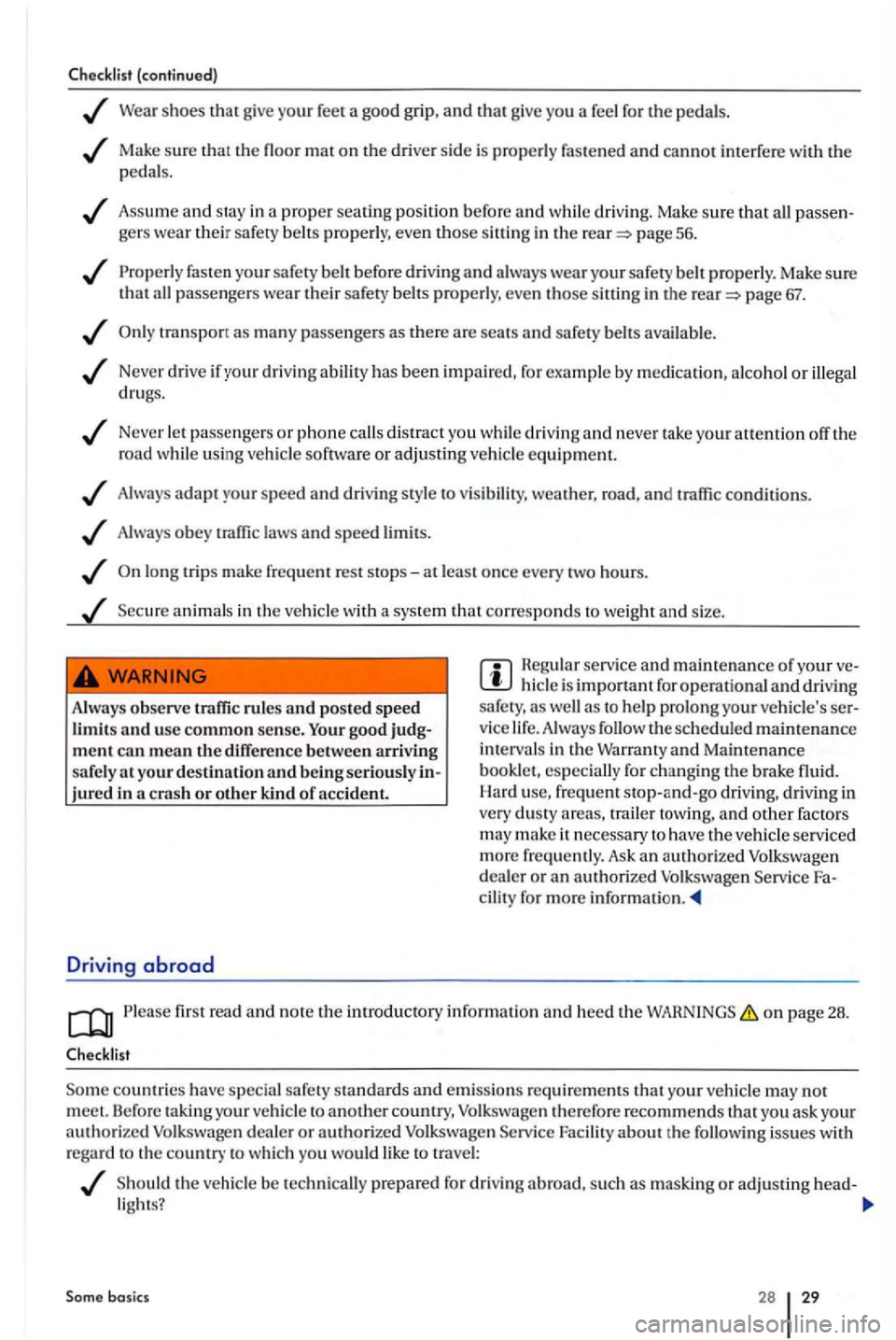
Checklist (contin ue d)
shoes th at give your feet a good grip , a n d that g ive you a feel for the pedals .
Make sure that th e floo r mat on the driver side is pro perly fastened and cannot interfere with th e
peda ls .
Assume and s tay in a proper seatin g positi o n before and driving. Make sure that gers wear their sa fety properly, eve n those siuing in the page 56 .
fasten your safety
transport as m any passenger s as
Never drive if your driving ability has been impaired , for exa mple by medication, alco hol or
Neve r le t passe nge rs o r phone d istract you driving and neve r take your attention off the road using vehicle software or adjustin g vehicle equipment.
Always adapt your speed and dri ving style to v isibility , weather, road, and traffic conditions .
Always obey traffic laws and speed limits .
long trips make freque n t rest stops -at least once every two hou rs.
Sec ure
animals in the vehicl e w ith a syste m that corresponds to we ight and s ize.
Always observe traffic rules and posted speed limits and use common sen se. good ment can mean th e diff erence between arrivi ng safe ly at your destination and b eing seriousl y jured in a crash or other kind of acci dent .
Driving abroad
Hegu lar serv ice and maintenance of your hide is important for operational and drivin g
safe ty, as the sc heduled maintenance
int erva ls in the
towing, and other fac tors
m ay make it necessary to have the ve hicl e serv iced more freque ntly. Ask an authorized Volk swage n
dea ler or a n authorized Volkswagen Service
on page 28 .
Checklist
issues with
regard to the country to which yo u wo uld like to travel:
Should the ve hicl e be technically prepared fo r dri vin g abroad, such as masking or adjustin g head-light s?
Some basics 28 29
Page 36 of 541
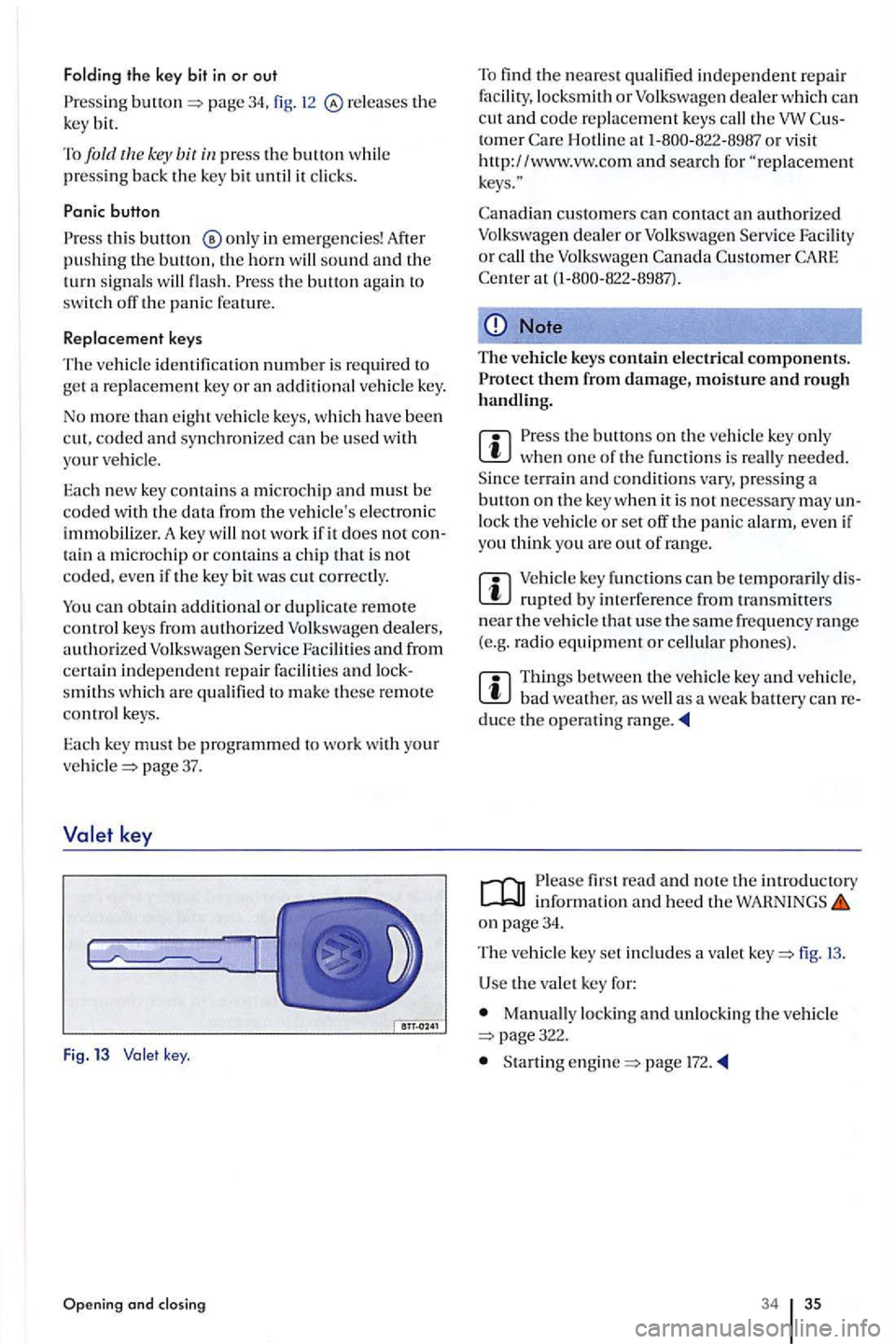
Folding the key bit in or out
Press ing page 34, fig. releases the
k ey bit.
To
fold th e key bit
this button in emergencies! After pushin g th e button, the horn will sound and the turn signal s will the button aga in to
sw itch off the panic fe ature.
Replacement keys
The ve hicl e id entifi cation number is required to
ge t a replacement k ey or an additiona l vehicle key.
No more th an eight ve hicl e keys , w hi ch have been
cut. coded and syn chroni zed can be used with your ve hicle .
E a c h n
ew key contains a microchip and must be coded w ith the data from the ve hicle's electroni c immobilizer. A key will not work if it does not co n
t a in a mi crochip o r co ntains a chip that is not coded, even if the key bit was cut co rrectly.
You can obtain additional or duplicate remote co ntrol keys from authorize d Volkswagen dealers,
authorize d Volkswage n Service Facilities and from certain indep end ent repai r facilities and locksmiths which are qualifi ed to make these remote control keys.
Eac h key must be programmed to wo rk with your pag e 37.
key
Fig . 13 key .
Opening and closing
To find the nearest qualifi ed ind ep endent repair fac ility, locksmith or Volkswag en d eal er w hi ch ca n
c ut and co de re placement keys call the tomer H otlin e at
cu stomers can contact an authorized Volkswagen dea ler or Volksw age n Serv ice Facility or call the Volk swage n
Note
The vehicle keys contain electrica l components.
the buttons on the ve hicl e key onl y when one of th e fun ctions is re all y needed .
S ince terrain and condition s vary , pressing a button on the key whe n it is not ne cess ary may un
l ock the vehicle or set off the panic alarm, eve n if
yo u think yo u are out of rang e.
m key fun ctions can be te mporaril y dis
bad weather. as well as a weak battery can reduce the operating range.
fir st read and note the introductory information and heed the WAHNINGS on page 34.
The ve hicl e key set includes a valet fig.
U se the va le t key for:
Manually locking and unlock ing the v ehicle page322.
Startin g page l72.
34 35
Page 59 of 541
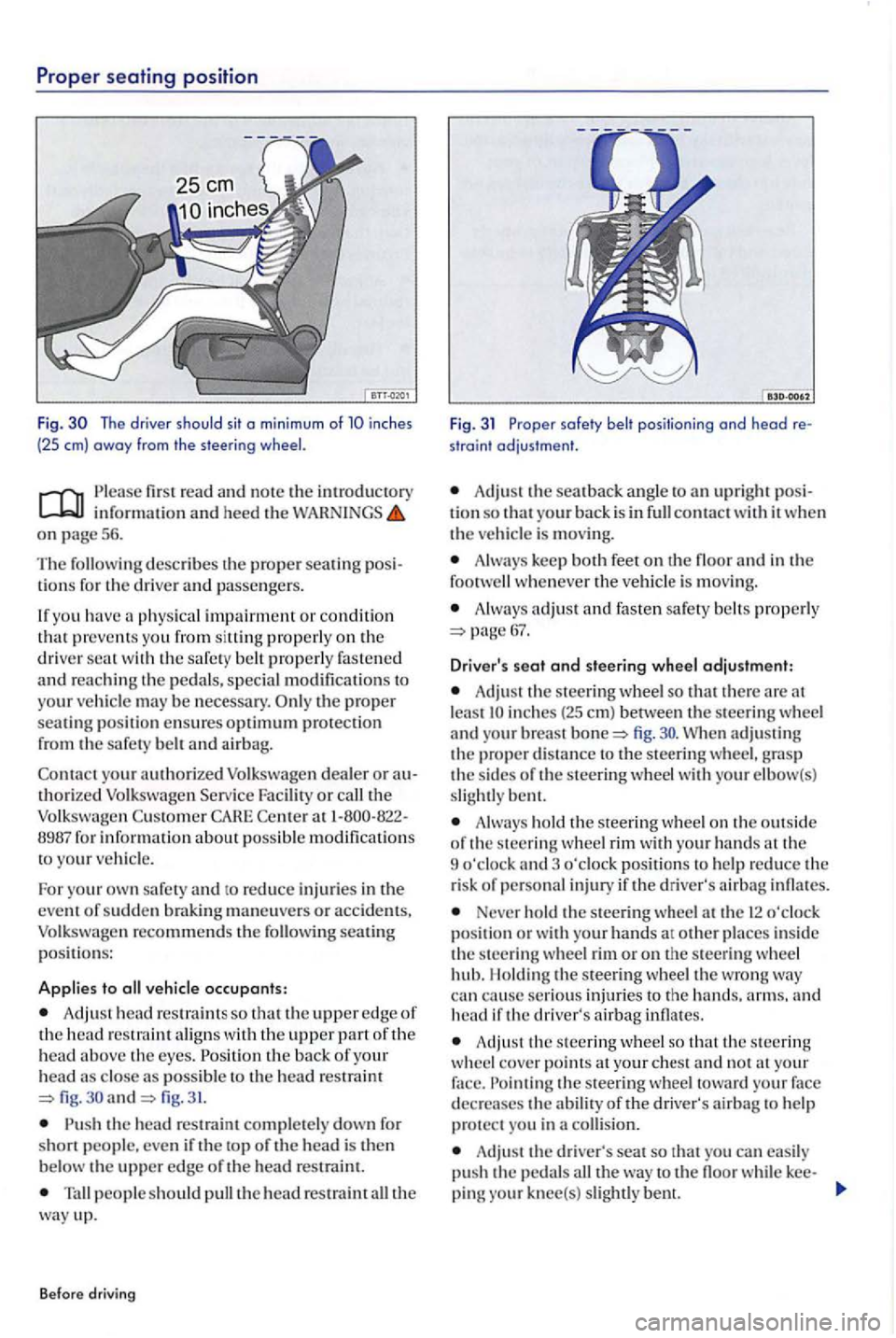
Prope r sea ting posit ion
Fig. The driver should sit o min imum of inches
(25 em) away from the steering
first read and note the introductory information an d heed the WARNINGS on page 5 6.
Th e
describes th e proper sea tin g lio ns for the driver and passengers .
If yo u hav e
physical impairment or condition that preve nts you from siltin g properly on the driver wit h the safe ty belt properly fastened and re a ching th e pedals, special modificatio ns to
your ve hicle may be necessary. p roper seating positi on ensures optimum protection from the safety belt and airbag.
Con t
act yo ur authorized Volkswagen dealer o r authorized Volk swage n Serv ice Facility or the Volkswagen Custo m er CAHE Cente r 1-800-822-
8987 fo r informati on about poss ible modification s
t o your ve hicl e.
F o r yo u r
own safety and to reduce inj urie s in the
event of sudde n brakin g maneuve rs or accid ents, Volkswagen recommends the seating p o siti ons:
Applies to vehicle occupants:
Adj ust head re straint s so that the upper edge of the head restraint aligns with the upper part of the head above th e eyes . the ba ck of your head close as poss ible fig. and fig. 31.
the head re straint completely down fo r
short people. eve n if the top of th e head is the n
b elow the uppe r edge o f the head re strai nt.
people s ho uld pull the head restraint the way up.
Before driving
Fig. 31 Proper safety belt positioning ond head re
straint adjustment.
Adjust the sea t back ang le to upri ght posi
tion so that your back is in conta ct w ith it w he n the vehicle is moving.
Alw ays keep both feet on th e floor a nd in the
foot whenever the vehicl e is mov in g.
A lway s adjust a nd fasten safety belt s pro perly
A dju st the steering wheel so that the re are lea st fig .
Always ho ld th e s teering wheel o n the out sid e
o f th e s teerin g wheel rim with your hands the
9 o'cloc k and 3 o'cloc k pos ition s to help re duce the
r is k of personal injury if the driver' s airb ag infl ates.
Never ho ld the steering wheel a t th e 12 o'clock position or w ith your hands at ot her places in side the steerin g wheel rim or o n the steerin g whee l
hub. l lo ldin g the steerin g w hee l the wro ng can cause se rious injurie s to the arms. and head if the driver's airbag infl ates.
Adju st the s teerin g wheel so that the s teerin g
w heel cove r points the ste erin g wh ee l toward your face
d ecrea ses the abilit y of the driver's airba g to help protect you in a collision.
Adju st the driver's seat so that you can easily
pu sh the pedal s the way to th e floo r while kee-
pin g knee(s) slightl y bent.
Page 67 of 541
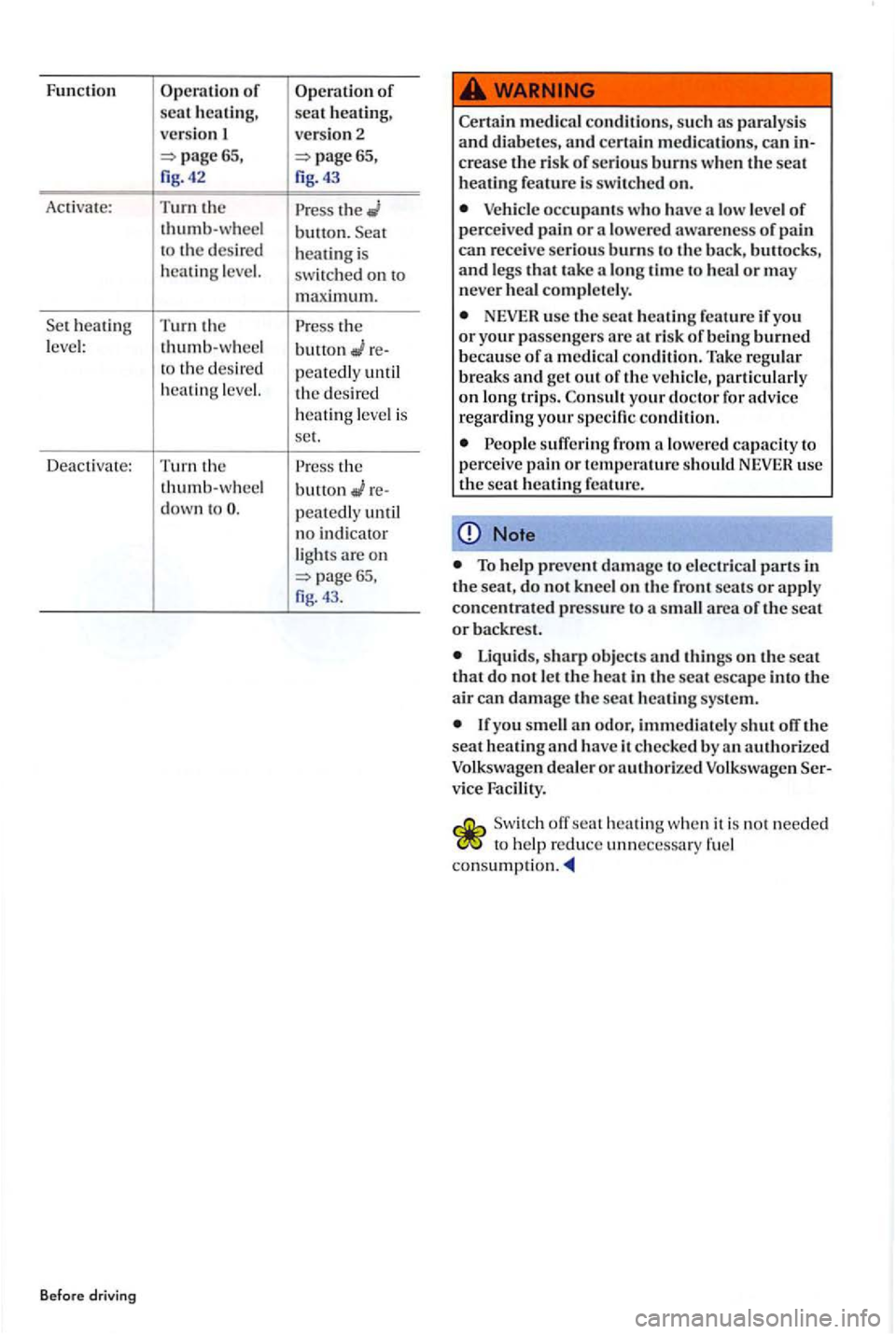
Function Operation of scat heating,
versio n
Activate:
Turn the
thumb-wheel
t o th e desired
h eat
ing level.
heatin g T urn the
l eve l: thumb- w heel to th e desired
heatin g level.
D eac tivate:
Turn the
thumb-w hee l
down t o
Befo re driving
Operation of sca t heating,
versio n 2
th e button. heating is
switc h ed on maximum.
the
button
re-
p
eat e dl y until
th e des ired
h
eatin g leve l is
set.
th e
button
rc-
pcat cdly until
n o indi cator
light s are o n
Certain medical conditions, su ch as pa ralysis and diabetes, and certai n medication s, can crease the risk of seriou s burns when the seat heating feature is swi tched on.
Vehicle occupants who have a low level of perceived pain or a lowered awareness of pain can rece ive seriou s burns to the back, buttocks, and leg s that take a long tim e to heal or may neve r heal completely.
NEVER usc the scat
To help preven t damage to elec trica l parts in the seat, do not kneel on the front scats or apply concentrated pressure to a small area or the seat or backrest.
Liquids, sharp objects and things on the scat that do not le t th e heat in the seat escape into the air can damage the seat heating system.
lfyou smell an odor, immediatel y shut off the seat heating and have it checked by an authorized
Volkswagen dealer or authorized Volkswagen vice Facility.
off
Page 73 of 541
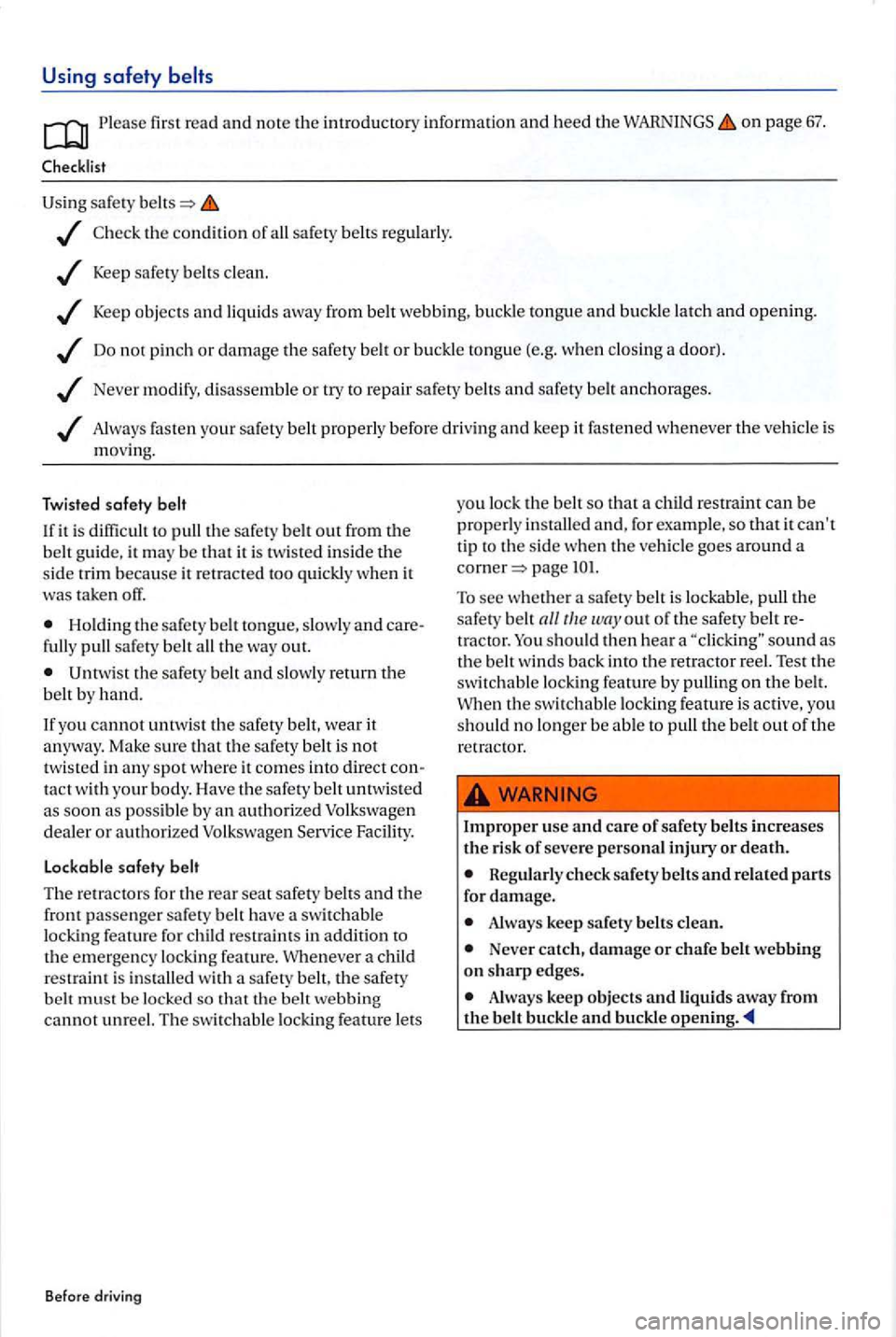
Using safety
P lease first read and note the introductory information and heed the on page 67.
the condition of all safety belts regul arly .
Keep safety belts clean .
Keep objects and liquid s away from belt webbing, buckle tongue and buckle la tch and opening .
Do not pinch or damage the safety belt or buckle tongue (e.g . w he n closing a door) .
Never modify, disassemble or try to repair safety belt s and safety belt anchorages .
Always faste n your safety belt properly before driving and keep it fastened whenever the ve hicle is moving.
Twisted safety belt
I f it is diffic ult to
pull the safety belt out from th e belt guide. it may be that it is twi sted insi de the side trim because it retracted too q ui ckly when it was take n off.
Holding the safety belt to ng ue, slowl y and fully pull safety belt all the way out.
Fa cility.
Lockable safety belt
Th e re tractors for th e rear seat safety belts and the fron t passenger safety be lt have a swit chable locking feature for child rest raints in addition to the emergency locking fea ture. a c hild
restraint is installed w ith a sa fety belt , the safety belt must be locked so that th e belt webbing cannot unreel. The switchable lockin g feature lets
Bef ore driving
you lock the belt so that a child restra int can be properly installe d and, for example, so that it can't tip to the side when the vehicl e goes around a page
To see whether a safety belt is lockable, pull the
safety belt n llrh e wnyout of the safety belt tr actor. should then hear a
th e switch able locking feature is active, you
s hould no lo nger be able to pull the belt out o f the retractor.
Improper use and care of safety belts increases th e risk of severe personal or death.
Regu larly check safety belt s and rela ted parts for damage.
A lways keep safety belts clean.
Neve r catch, damage or chafe belt webbing on sharp edges.
Always keep objects and liquids away from the belt buckle and buckle opening.
Page 79 of 541
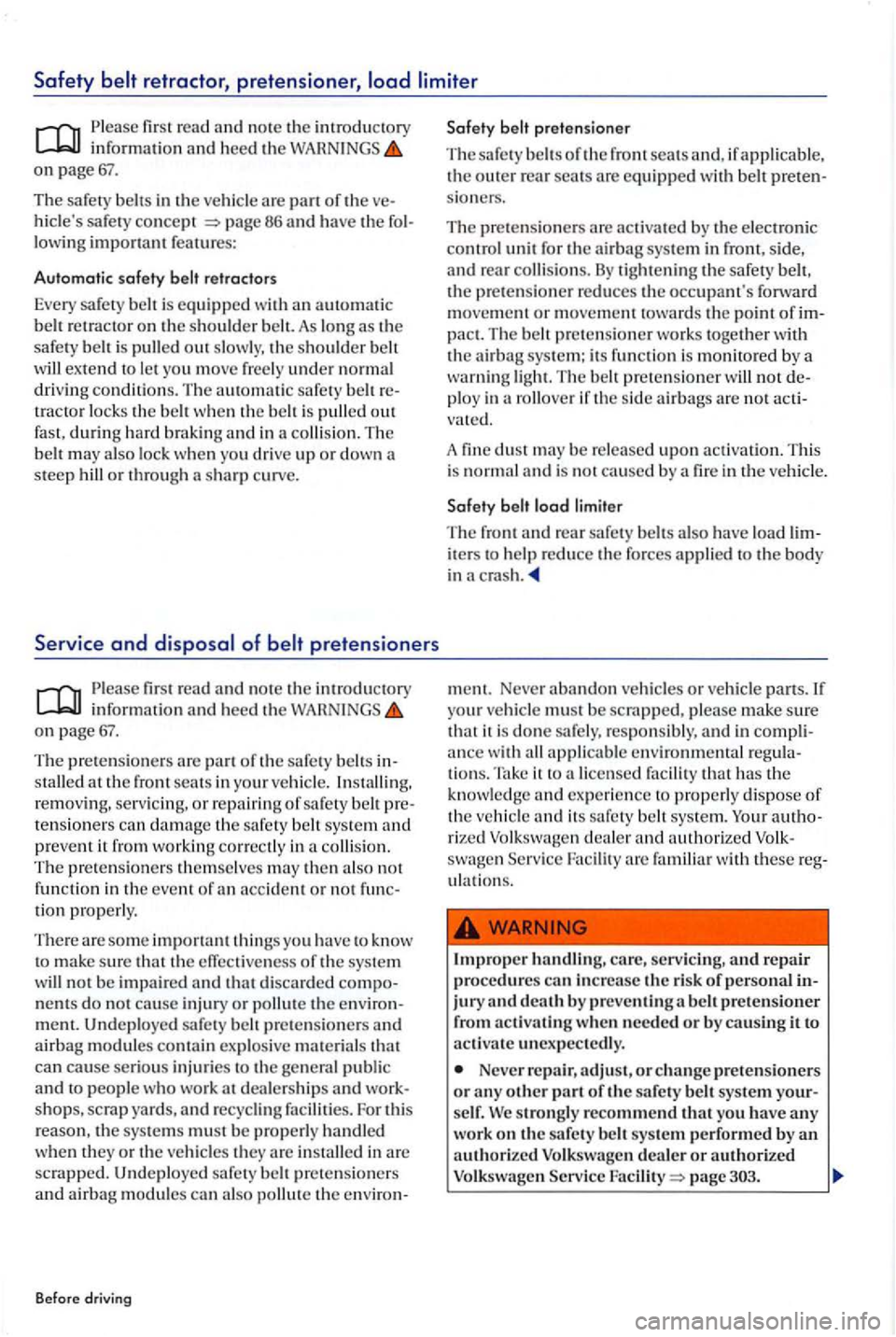
information an d h eed the on page
The safety belts in the ve hicl e are part of th e 86 and have the lowin g important features:
Automatic safety
th e safe ty belt is pull ed out slowly , the s h o ulder b elt will extend to l et yo u m ove freely under normal
driv in g condition s. The auto m atic safe ty belt tra cto r locks th e belt when the belt is pull ed ou t fast, d uring hard brakin g and in collision. T he
b elt may also lock when you dri ve up or down steep hill o r th rou gh a sharp cu rve.
informatio n and heed the on page
The prete nsione rs are part o f th e safe ty belt s stalled at th e fro n t in your ve hicle . I nstallin g.
r e mov in g, serv ic ing, or rep airin g of sa fe ty belt ten sio ne rs c an damag e th e s afety belt sys te m
tion properly.
Th ere are some import ant things yo u have to kn ow
to m ake sure that th e effective ness o f th e system w ill not be impair ed and that discar ded nents do n ot ca use inj ury or pollut e the men t. Undeployed safet y belt pre te nsio n ers and air b ag mod ules co ntain explos ive mate ria ls can cause seri o us injuries to the ge neral public
and t o people
in are sc rapp ed. Und ep lo ye d safet y belt pre tensio ne rs
a n d airba g m odules can also pollut e th e en vir on -
B efore driving
s ion ers.
Th e pr eten sio ne rs
are activated by the e le ctronic
c ontrol unit for the airbag system in front, s id e, and rea r collisions. tight ening the s afet y belt , the prete nsio ner reduces th e occupan t's fonvard
m ove ment or movement towards th e point of pact. T he belt pr ete nsioner wo rks toge ther with
th e airbag syste m ; its fun ction is monito red by a
wa rning ligh t. Th e belt prete n sione r will not
va te d .
A
dus t b e re leased upon a ct iva tion. This
i s no rmal and is no t caused by a in th e vehicle .
load l imiter
The front and rear safe ty belt s also have load iters to help reduce the fo rces applie d to the b o d y
in
m ent. Neve r abandon vehicles or vehicl e pa rt s. If
your veh icle mu st be scrapp ed, please make sure
that it i s done safe ly , re sp o nsibly, and in
swage n Fac ility familiar with these
'
Impro per handli ng, care, servici ng, and re pa ir
p rocedures can increase th e risk of p erson al ju ry and death by prev ent in g a bel t p re te nsioner from act iv ating w he n n eeded or by ca usi ng it to
a c ti vate unex pec tedly.
Neve r repair, adjust, or c hange pretensioners or any o ther part of th e s afety belt syste m strongly recom mend that you have any work on th e safety belt sy ste m perform ed by a n
a uth o riz ed
page
Page 82 of 541
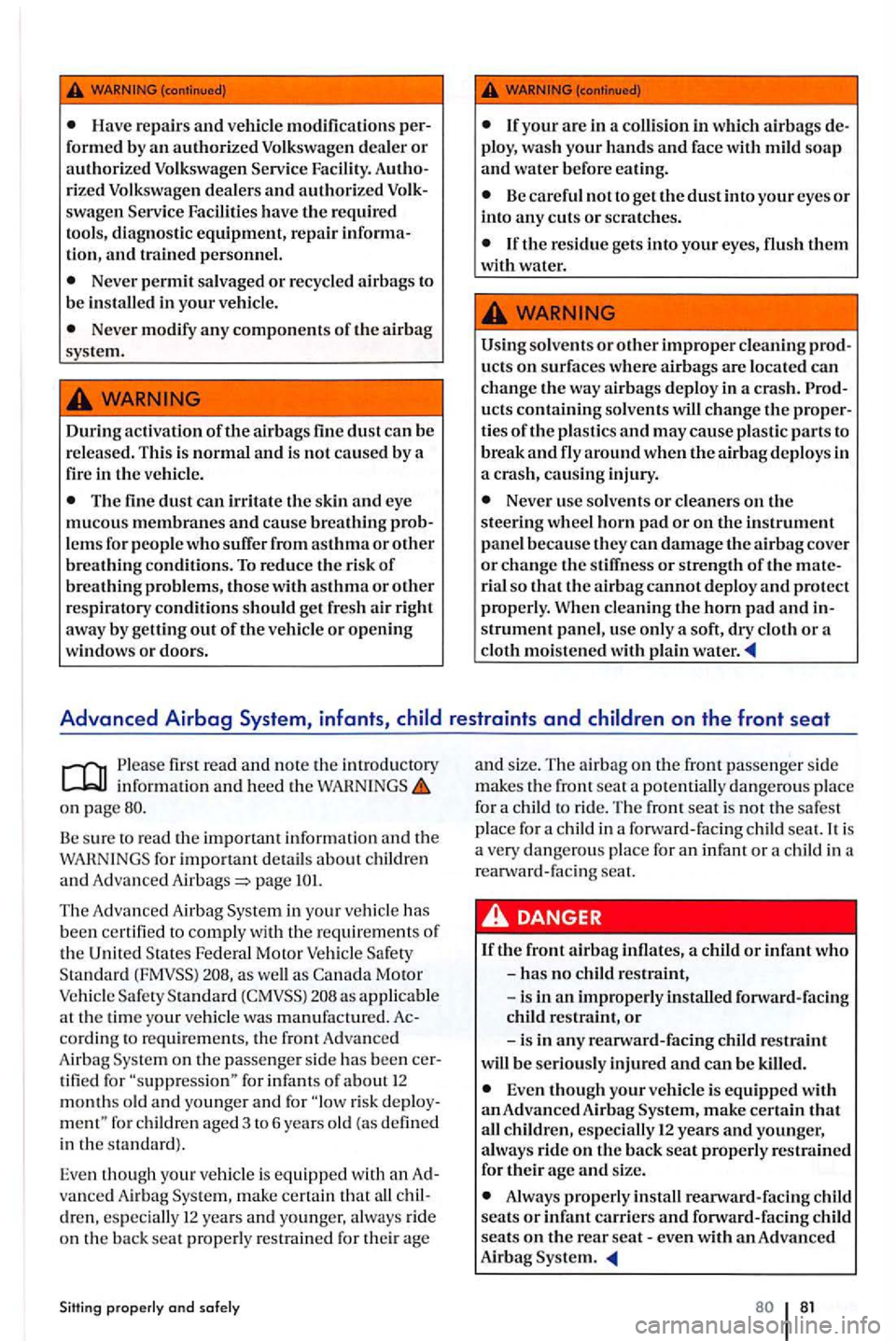
Have repairs and vehicle modification s
rized Volkswagen dealers and authorized swagen Facilities have the required
tool s, dia gnostic equipment, repair tion, and trained personnel.
Never permit salvaged or recycled airbags to be installed in your veh icle.
Never modify any components of the airbag syste m.
During activation of the
The fine dust can irritate the skin and eye muco us membranes and cause breathing lems for people who suffer from asthma or other breathin g conditions. To reduce th e risk of breathing probl em s, those with asthma o r o th er
r es piratory
Be careful no t t o ge t the dust into your eyes or
into any c uts or sc ratches.
Using so lve nts or other improper cleaning
u cts containing so lvents w ill ch ange the ti es of the plastic s and may cause plastic parts to break and fly around when the airbag deploys in a crash, causin g injury.
Never usc so lven ts or cleaners on th e
s teering wheel horn pad or on the instrument pan el b eca use they ca n damage the airbag cover or change the s tiffness or strength of the rial so that the airba g cannot deploy and protect properly. When cleaning the horn pad a n d strument panel, use onl y a soft, dry cloth or a
cloth moistened w ith plain water.
Please first read and note th e introductory informatio n and heed the WARN INGS on
Be sure to read the important inform ation and th e for important detail s about child ren
and Adva nce d Airbags
in you r ve hicl e has
been ce rtifi ed to comply wit h th e requirement s of the Unit ed Federal Moto r Vehicle as well a s Motor Vehicl e as a pplicabl e
at the time your vehicle was manufactured. co rding to req uirement s, th e front Advance d
A ir bag on th e passeng er side h as been tified for for infant s of about 12
months old and you nger and for risk for ch ildren aged 3 to 6 yea rs old {as defined
in the stand ard ).
Even th ough your vehicl e is equipp ed w ith an vance d Air bag mak e ce rtain that all dre n, es pecially 12 years and younge r, a lways ride
o n th e back seat properly restra ined for their a ge
Sitting properly and safely
and size. The airb ag on the front passenge r side m ak es the fron t seat a potentially dangerou s pla ce for a child ride. Th e front seat is no t th e sa fest
p lace for a child in a fo rward -faci ng chil d seat. is
a very dangerous place for an in fant or a child in a
r earward-fac ing sea t.
is in an improp erl y in stall ed for ward-faci ng
child res traint, or
in an y rearward- facing child restraint
will
be se riously injur ed and can be kill ed.
Eve n though your vehicl e is equipped with an Advance d Air bag make certain that aU children, especia lly years and you nger,
a lwa ys rid e o n the back seat properly restrained
for their age and s ize.
Always properly install reanvard-facing child seats or infant carriers and forward -faci ng c hild
s eats on the rear seat-even with an Advanced
81
Page 86 of 541
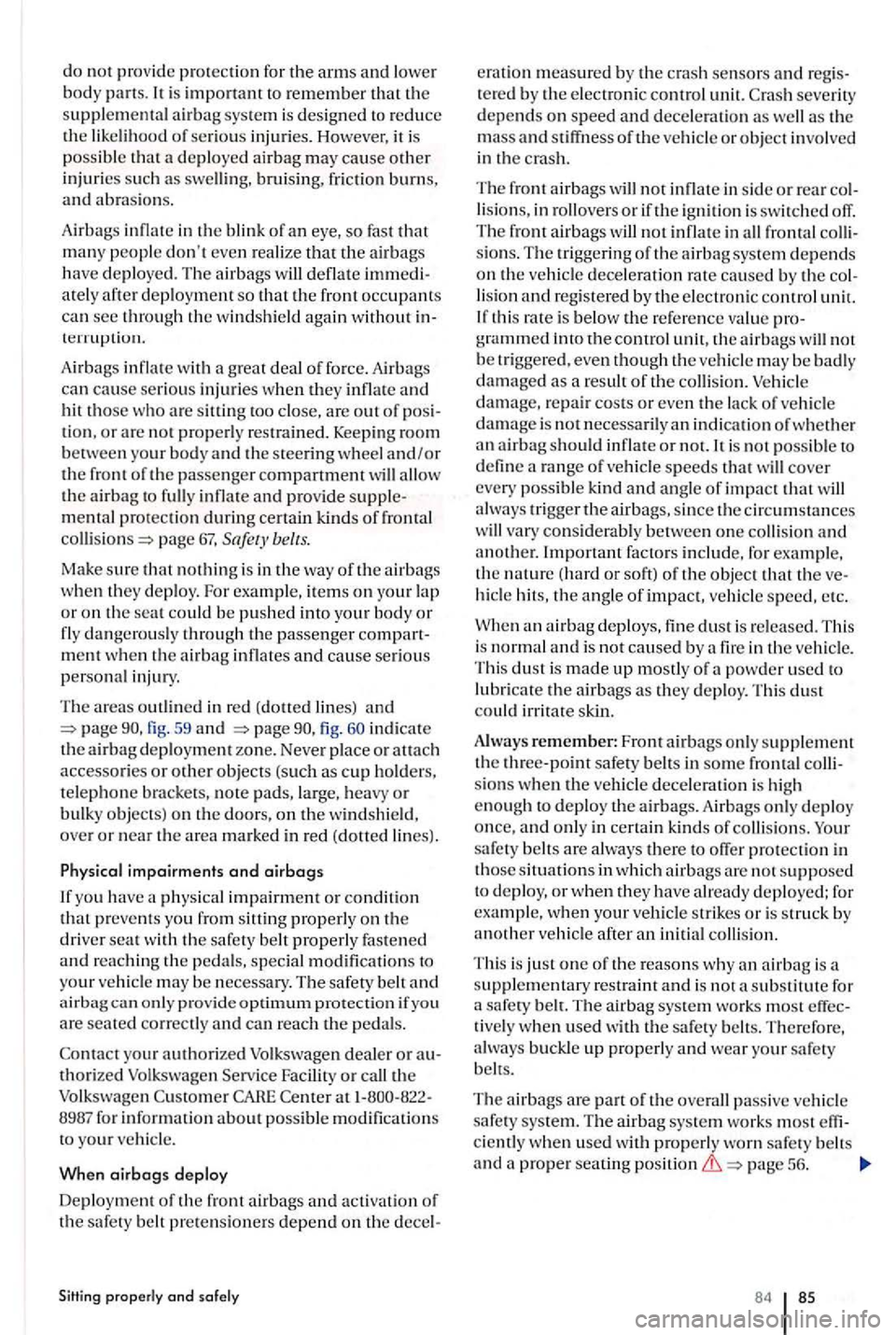
do not provide protectio n for the arms and lower body parts. is important to remember that th e
supple m ental airbag system is designed to reduce the likelihood of serious in juries. However, it is poss ibl e that d ep lo ye d airbag may cause other injurie s such as swelling, bruising, friction burns, and abrasio ns.
A irba gs inflat e in
the blink of an eye, so fast that many people don't eve n realize th a t the airbags
h ave dep loyed. The a irbags will deflate ate ly after deployment s o that th e front occupants can see th roug h the windshield again without terruption.
A ir
bags inflat e with a grea t deal of fo rce. Airbags can cause serious in juries when they infl ate and hit those who are sittin g too close, are out of
mental protection durin g certain kinds of frontal
collisio ns page 67, Safety belts.
Make s
ure that nothing is in the way of the airbags when th ey deploy. For example, items on your lap or o n th e seat could be pushed into yo ur body or fly dangero usly through the passenger ment w he n the ai rbag inflates and cause serio us personal injury.
T he areas outlined in red (dolled lines) and fig. 59 and fig. ind icate the airbag deployment zone. Never place o r aLtach
accessories or other o bjects (such as cup hold ers, telephone bracke ts, note pads, large, heavy or bulky objects) on the doors, on the w indshie ld, over or near the area marked in red (dotted lin es) .
Physical impairm ents and airbags
If yo u have a physica l impairment o r condition that prevents yo u f rom sitting properly o n the driver seat with the safety belt properly fastened
a n d reach ing the pe dal s, special modifications to
your ve hicle may be necess ary. The safety belt and airbagcan only provide optimum p rotection if you
are seated correct ly and can reach the p ed als.
thorized Volkswagen Service Facility or call the
te red by the electron ic control unit. seve rity
depends on speed and decele rati on as well as the mass and stiffn ess of the ve hicle or object in vo lved
in the cras h.
The front airbag s will not inflat e in sid e or rear lisio ns, in roll overs or if the ig niti on is swi tc h ed off .
T he front airbags will not inflate in all frontal sions. The trigger ing of th e a irbag system depends on th e ve hicle dece le rat ion rat e caused by the lisio n and registered by the electr onic control unit. If th is rat e is below the refer ence va lue grammed the control unit, th e a irba gs will not be trigge red, even though the vehicle may be badly damaged as a resu lt of the collision. Vehicl e
damage, repair costs or even the lack of ve hicl e damage is not necessarily an ind ication of whether
a n airbagshould inflat e or not. It is not possib le to
defi ne a range of vehicl e speeds w ill cove r
every possibl e kind and angle of impact that will
a lways trigger the airbag s, s ince th e c ircumstances
will vary con sid erably between one collis ion and a not her. Important facto rs include, for example , the nature (hard or soft) o f the objec t that the hicl e hit s, the angle of impact, ve hicle speed , etc.
When a n airbag deploys, fine dust i s released. This
i s normal and is not caused by fire in the ve hicle.
T hi s d ust is made up mostly of a powder used to
lub ricate the airbags as
s ions when the veh icle deceleration is high enough to depl oy the airbags. Airbags onl y deploy
once, and o nl y i n certain kinds of collisions. safet y belts are always there to offer protectio n in
th ose situ ation s in which airbags are no t s upposed to dep loy, or when they have already deployed; fo r example, when your vehicl e strikes or is st ru ck by
anothe r ve hicle after an initial coll is ion.
is just one o f the reasons w hy a n air bag is supplementary restraint and is not a substitute for a safe ty belt . The airbag syste m wo rks most
The air bags are pan of the overall passive vehicl e safe ty sys tem. The airbag system works most cie ntly when used with properly safety be lts and a proper seatin g posit ion
84 85